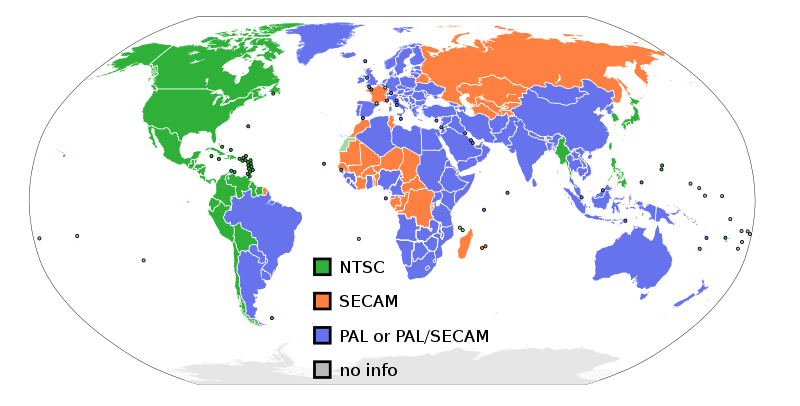PAL (Phase Alternating Line)
The PAL standard is a method of color frequency modulation in television broadcasting, with the full name Phase Alternating Line. Apart from the NTSC standard used in North America and parts of East Asia, and the SECAM standard used in the Middle East, France, and Eastern Europe, most regions of the world use the PAL standard. PAL was proposed by Walter Bruch, a German, in 1963 while working for Telefunken.
In the 1950s, Western Europe was planning for color television broadcasting, but the NTSC standard had many defects, including color tone shifting under poor reception conditions, leading to the nickname for NTSC as Never The Same Color. To overcome the shortcomings of the NTSC standard, Europe needed to develop a color television standard suitable for its region, leading to the PAL and SECAM systems. Both have a frame rate of 50Hz, unlike NTSC's 60Hz, which is suitable for Europe's 50Hz AC power frequency.
The PAL standard was designed by Walter Bruch at Telefunken in West Germany and was introduced in 1963. The BBC was the first broadcaster to use this standard, testing it on its BBC2 channel in 1964 and officially starting full-color broadcasting in 1967, while West Germany also started in 1967. The International Telecommunication Union formally defined the PAL color broadcasting standard in 1998 as Recommendation ITU-R BT.470-6, Conventional Television Systems.
“PAL” is sometimes used to refer to the 625 lines, 25 frames per second, interlaced scanning, PAL color modulation television format (576i). This differs from the 525 lines, 29.97 frames per second, interlaced scanning NTSC format (480i), which is commonly labeled as NTSC or PAL on DVDs.
The original intent of the PAL invention was to incorporate color signals while maintaining compatibility with existing black-and-white television formats. The principle of PAL is similar to NTSC. "Phase Alternating Line" means that the color signal of each scan line is alternated with the previous line to automatically correct any phase errors that may occur during transmission. Early PAL televisions did not have special components to correct phase errors, and sometimes severe phase errors were visibly noticeable. Modern televisions average the color signal from the previous line with the next line before displaying it. As a result, the vertical color resolution of PAL is lower than that of NTSC. However, since the human eye is less sensitive to color than to light and dark, this is not a significant issue.
NTSC televisions require tint control to manually adjust colors, which is one of NTSC's major drawbacks.
PAL itself refers to the color system and is often paired with the 625 lines, 25 frames per second interlaced scanning television broadcast formats: such as B, G, H, I, N. There are also PAL formats associated with other resolutions: for example, Brazil uses an M broadcast format with 525 lines, 29.97 frames (the same as NTSC), using NTSC color subcarriers, but Brazil uses PAL color modulation. Most PAL televisions can receive all the different system formats of PAL. Many PAL televisions can also receive NTSC-M baseband signals, such as those from video game consoles and VCRs. However, they may not necessarily be able to receive NTSC broadcasts.
When the video signal is transmitted in baseband (for example, from video game consoles or VCRs), the distinctions between various broadcast formats defined by "letters" no longer apply. In this case, PAL refers to: 625 scan lines, 25 frames per second, interlaced scanning, PAL color modulation. For digital media such as DVDs or digital broadcasts, the format also does not differ; in this case, PAL means: 625 scan lines, 25 frames per second, interlaced scanning; which is identical to SECAM.
In the UK, Hong Kong, and Macau, PAL-I is used. Mainland China uses PAL-D, while Singapore uses PAL B/G or D/K.
Films are generally shot at 24 frames per second. When films are broadcast on PAL televisions, they are played at 25 frames per second, resulting in a 4% speed increase compared to cinema or NTSC broadcasts. This difference is not very noticeable, but the music in the film may sound a semitone higher. If the broadcaster does not adjust for compensation, careful listeners may notice this.
The following are countries that adopt the NTSC system (in blue)

- The above article content is excerpted from Wikipedia
Wi-Fi Network Planning Advice
15 Tips for Hard Drive Longevity
10 Things About Image Analysis
知識學院
蘊藏許多助人的知識與智慧。